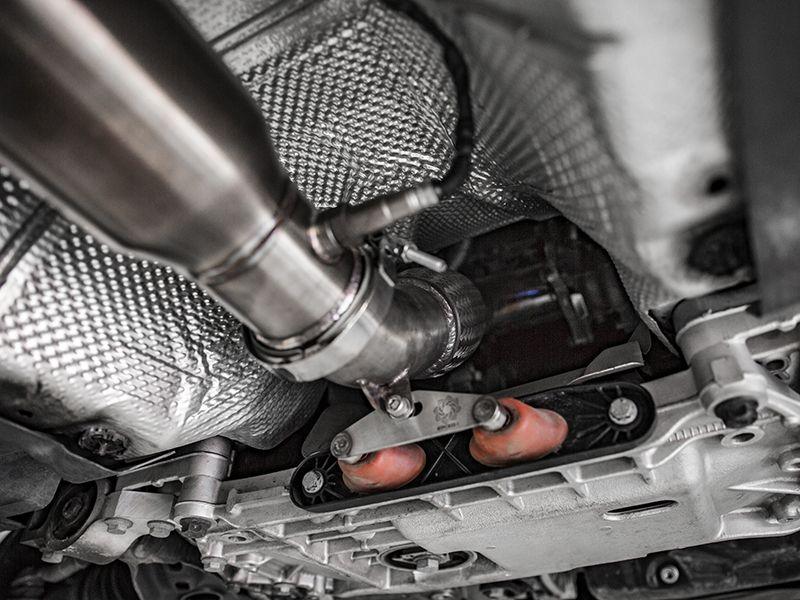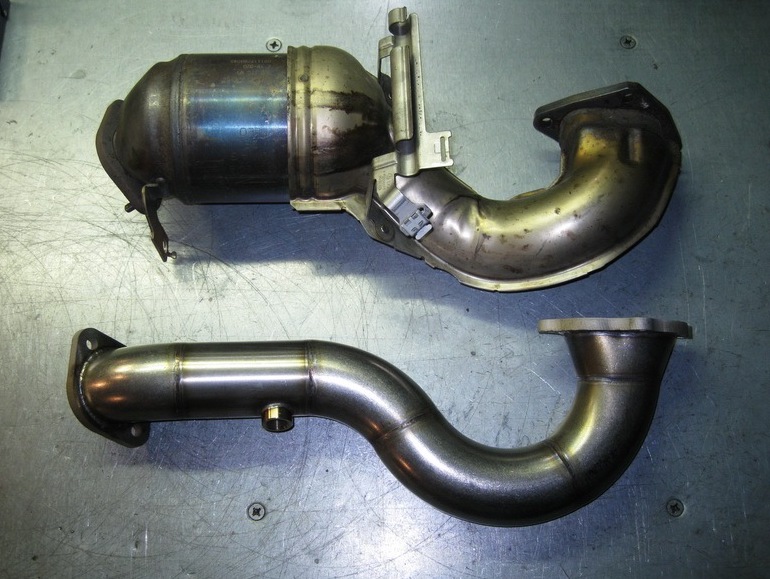
Downpipe - what is it?
Content
- What does Downpipe look like?
- Downpipe in engine and turbocharger operation
- The importance of downpipe
- Downpipe manufacturing problem
- Where downpipe is used
- Video review of the collector and downpipe on the classic 16v
- Does my car have a downpipe?
- When should you change your downpipe?
- Benefits of downpipe tuning
- Questions and answers:
Downpipe is an important part of the exhaust system of any vehicle, passing between the exhaust manifold and the catalytic converter (catalyst). Many car enthusiasts pay very little attention to this pipe because it does not significantly affect the performance of an atmospheric gasoline engine.

Downpipe - this is a pipe that helps to divert exhaust gases from the engine to the turbine, thereby spinning it. Connects directly to the exhaust manifold and turbine.
What does Downpipe look like?
The downpipe is simply a 40-60 cm long pipe that starts right after the turbine and connects to the exhaust system.
Usually used only on vehicles with turbo engines. Since the turbine is located between the manifolds on the head and the exhaust, and to connect to the exhaust system, you need a pipe that lowers the exhaust line.
This hardly makes sense, but on naturally aspirated cars, manifolds that start from the head connect to the exhaust pipe towards the bottom of the car.
On vehicles with turbochargers, a section of pipe (downpipe) is needed to connect the turbine to the rest of the exhaust system, which is below the engine, which is why it is called a downpipe.
Inside this pipe section is usually a catalyst or particulate "filter" (in the case of diesel engines). Basically, it is a component with a filtering function that serves to reduce exhaust emissions.
In the photo below, you can see the downpipe fitted as standard on the car, which has been cut open to reveal the insides.

Where is it located?
The downpipe is located between the turbocharger and the exhaust system and often contains (depending on vehicle type) a pre-catalyst and/or main catalyst and an oxygen sensor. The larger downpipe diameter provides improved performance and richer sound.
Downpipe in engine and turbocharger operation
Both the turbocharger and the engine are essentially pumps. In this case, the biggest opponent of any pump is limitation. Limiting exhaust emissions in a car engine can cost it power.
The low permeability of the exhaust makes it work harder to clean the cylinder for the next cycle, using energy that can't be used to move the car. Intake restriction restricts the mixture of air and fuel that allows combustion, thus limiting power.
The importance of downpipe
As we discussed earlier, the easier and more exhaust gases are delivered to the turbine, the more power the engine can deliver. The big advantage of the tailpipe is that it provides less resistance to exhaust gases than standard tailpipes, which allows the turbine to spin faster and build up more pressure.

Downpipe manufacturing problem
The main problem with downpipes is their manufacture. It's no secret that each car is unique in its layout, even two identical models, but with different engines, have a different layout of the engine compartment. In this regard, downpipes have to be made curved in different planes in order to fit them correctly.
In the process of manufacturing such pipes, ripples and irregularities may appear on the inner side of the pipe at bending points. Such irregularities lead to the formation of turbulence and turbulence, which reduces the flow of exhaust gases. Performance downpipes are smoother with no internal ripples, thus providing better exhaust flow and more power from the turbocharger.
Where downpipe is used
This type of branch pipes is mainly used for self-tuning of engines, when an atmospheric engine is initially installed, and they want to make it turbocharged.
The turbine needs to be untwisted somehow, respectively, an exhaust gas supply is required, but where can I get it if in the standard system there is only an exhaust manifold and then the exhaust pipe itself? It is in such situations that the downpipe is installed, namely, the exhaust manifold is being finalized (more often a “spider” is installed), from which the downpipe already diverts exhaust gases to the turbine and spins it.
Video review of the collector and downpipe on the classic 16v
Does my car have a downpipe?
If your car is turbocharged (diesel or petrol), it must be equipped with a downpipe (remember, this is a connecting tube).
If your car is atmospheric, do not install a downpipe on it, as it is useless. The latest generation cars are almost always turbocharged, so they already have the original downpipe as standard.
With the InoxPower downpipe, you can get a noticeable increase in power, higher than with a simple ECU remapping, as well as improved sound, the only real block that doesn't make your engine roar.
When should you change your downpipe?

Typically the downpipe with filter is a wear-prone component, in particular this appears to be the case on diesel engines where the DPF tends to clog and is often difficult to repair over time. In this guide, we won't go into the details of why this happens. Here we'll focus on the reason you usually swap out a stock downpipe for a racing one, which is to increase the power.
If you make any improvements to increase the power of a car with a turbine (I remind you that these are changes that need to be made only for running in a closed circuit), the first step is the classic “map” into the control unit.
By itself, this would already be enough modification to get the first increase in power.
But if you want to get the best performance out of your engine without interfering with the turbocharger, pistons, connecting rods, or power pack, and WITHOUT jeopardizing RELIABILITY, then there's the next step, often referred to as "stage 2."
Stage 2 essentially consists of installing a racing downpipe, an intake and a special map (the term stage 2 is generic, sometimes including other modifications).
The bottom line is to replace the doupipe with a sporty one. INOXPOWER. A simple step that, however, radically changes the result, allowing a significant increase in power.
But it doesn't stop there...
Benefits of downpipe tuning
Downpipe tuning will bring several effects, all based on the reduction of exhaust backpressure due to the downpipe's larger diameter:
- reduction of exhaust gas temperature, reduction of heat load
- reduced exhaust gas backpressure, less mechanical stress
- Maximizing productivity
- higher torque
- power increase
- best driving experience
- improved sound, also heard in the car
Questions and answers:
What is the downpipe for? Downpipe - literally "downpipe". Such an element is installed in the exhaust system. It connects the turbine to the exhaust system if the standard muffler in a turbocharged internal combustion engine does not cope with the task.
How much power does Downpipe add? It depends on the features of the turbocharged engine. Without chip tuning, the power increase is 5-12 percent. If we also carry out chip tuning, then the power will increase by a maximum of 35%.
Where is Downpipe installed? Most often they are installed on tubed motors for quick exhaust gas removal. Some install such an element on a naturally aspirated engine.


One comment
Nazim
Hello. Is it allowed to install a downpipe according to the legislation of Azerbaijan? Or does it violate article 342.3?